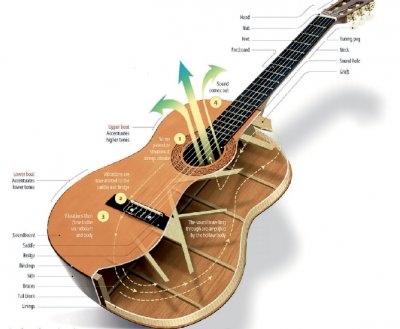+ A
A -
Amit Newton
Doha
Contrary to popular belief that the soundhole is to project the 'sound' out of the guitar, the purpose of the soundhole is simply to allow the air pressure inside and outside the guitar cavity to equalise as the top vibrates. The sound hole doesn't act like a speaker; it just allows the top to vibrate more freely by releasing air pressure inside the guitar body.
However, increasing or decreasing the diameter of the hole affects the flow of air, which in turn does affect the sound emanating from the top of the guitar. The normal sized circular sound hole on a steel string acoustic guitar is 4 inches across. Making the sound hole smaller would tend to make the guitar have more bass (because it allows lesser air to escape). Making the sound hole larger would accentuate the treble (because the more the air escapes, the more is the volume).
Going by that argument, it wouldn't be wrong to surmise that the soundhole does not need to be any particular shape at all. Why, then, is it almost always round, and so very near the centre of the guitar?
This is because of the simplicity of design, it is easy to cut, and aesthetically pleasing in general. But the greatest advantage of having a round soundhole is that it allows relatively easy access to the interior of the instrument in case repairs are ever needed. Say, fixing a loose brace, or installing a pick-up system.
Without a round soundhole positioned where it is, such basic repairs and modifications become a nightmare (which is why you'll have to pay much more to repair something inside an archtop guitar). In extreme cases, the top of the instrument would have to be removed entirely in order to access the interior.
Offset soundholes
A lot of experimentation has gone into putting soundholes in different places on the top and also in different shapes. The different shapes are more often than not for visual effect but in addition, sometimes, soundholes need to be made in different shapes or put in different places because the bracing pattern underneath the top has been changed.
In fact, if you place the hole on the side of the guitar, with the top having no soundhole at all, you would not notice a very significant difference in the volume of the instrument.
But why do guitars with holes on their sides sound louder? Holes not positioned on the top of an acoustic guitar are called soundports. They are usually supplementary to a main soundhole, and being located on an instrument's side facing upward in playing position, allow players to monitor their own sound.
But are offset soundholes a fad or a thing of the future? Offset soundholes have been around for a while, and more and more companies are experimenting and offering offset soundholes. Most will say that the offset soundhole increases top movement because with the traditional round soundhole out of the way, they can change the bracing pattern, which can really change the tone of the instrument. Offset soundholes that are closer to the player better project the sound to the player while not stealing sound from the audience.
Multiple soundholes
The Adamas line by Ovation has several very small soundholes on either side of the body near the neck, in what Ovation considers to be an attractive arrangement. Their argument is, since it is just the displacement of a certain volume of air in question, whether that volume is displaced through one large hole or several small holes, should not matter. And rightly so, the many holes do not hamper sound, or its quality.
NEXT TIME: Ebony or rosewood for the fretboard?
To comment, compliment or criticise, write in to [email protected].

